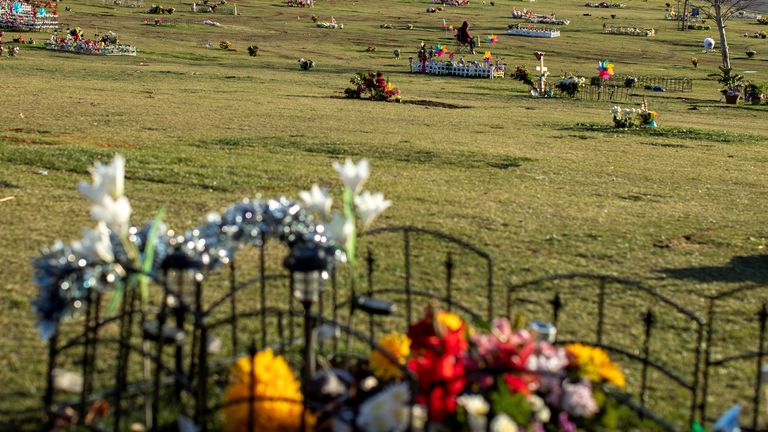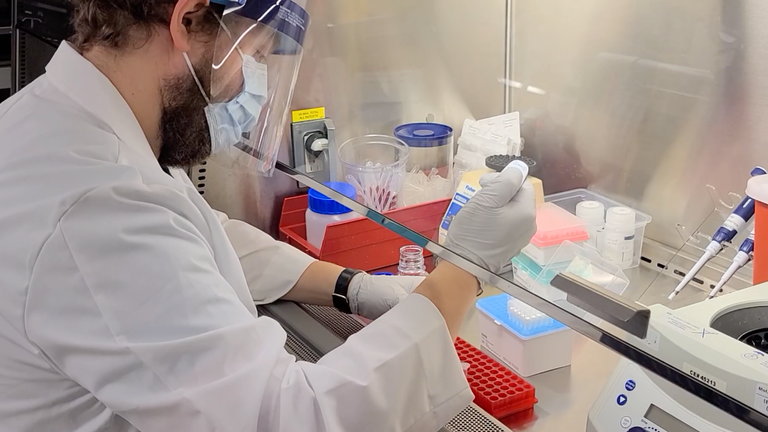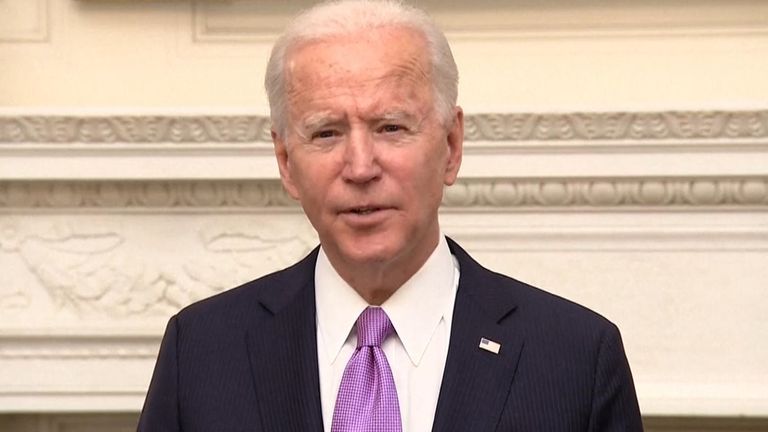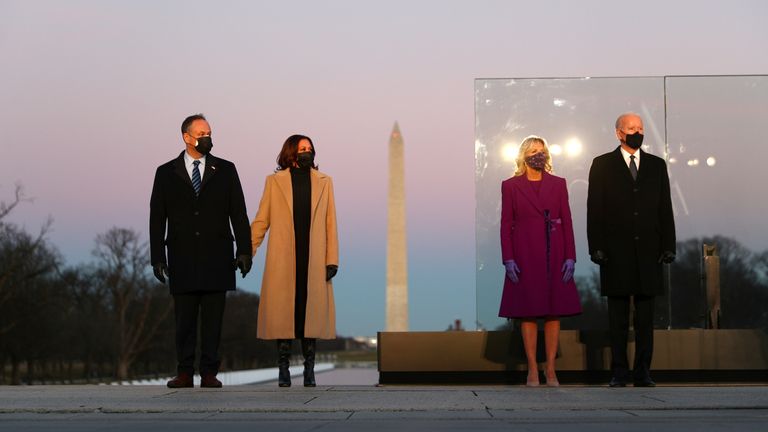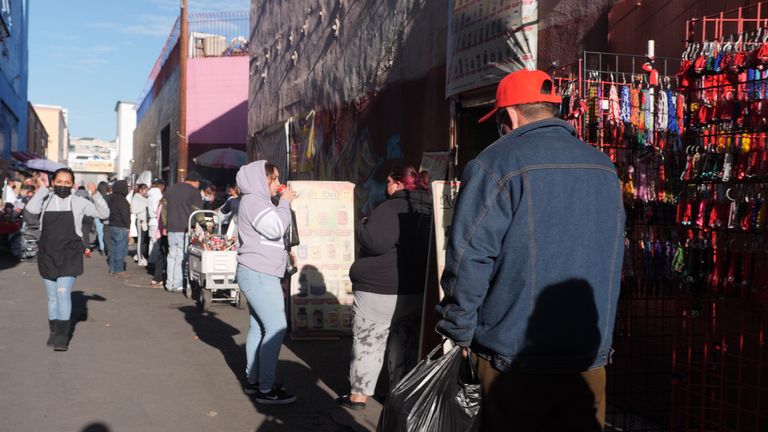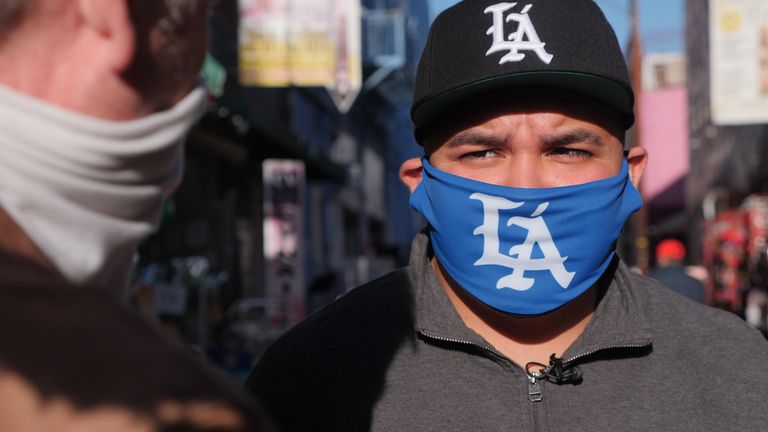Scientists in Los Angeles searching for signs that the UK COVID variant had crossed into the US have stumbled on a different one that appears to have been home grown in California – fuelling a surge in cases in the world’s entertainment capital.
Nearly 50% of all new coronavirus cases in southern California in January alone are traced to the new variant, CAL.20C, one of the pathologists to identify the strain told Sky News.
It is far higher than previously believed.
Live COVID updates from UK and around world
Los Angeles County had survived much of the worst of the pandemic that has put the US at the top of the death chart from COVID-19 worldwide. At the time of writing, more than 440,000 Americans have died.
But in recent months, LA has seen a huge spike in mortality rates and has seen the virus spread throughout the most vulnerable communities in the city, particularly the homeless, who had initially been the least affected.
Doctors and researchers at the world-famous Cedars-Sinai medical institution are still testing to see if the California variant is more deadly, more virulent, and more resistant to vaccines, like it is feared others might be.
They found the new strain only because they realised that British scientists were far ahead in seeing the importance of testing for variants.
“I think that to your credit in the UK, you really showed up other health systems around the world by finding that variant and realising that clinical sequencing and sequencing of these genomes is important,” Dr Eric Vail, who has co-authored the study on the new strain, said.
“Once the UK variant was found and we’d seen that it was starting to spread, there was a lot of interest in detecting it and seeing if it was here, and that’s where this whole thing started.
“And then we found our own variant. So if you don’t look for it, you’re never going to find it, and so I think that that’s really a lesson you can take from this whole thing.”
What has become clear around the world is that coronavirus is changing all the time and that is what scientists have to continuously monitor.
The virus is constantly evolving to avoid the immune system, and what is interesting about CAL.20C is that it is developing in a completely different way to the UK, South African and Brazilian variants.
“You’re literally proving evolution right as you go, that’s what’s going on,” said Dr Vail.
“Every single person that this virus infects is a little incubator and a little evolution chamber, and so it has a chance to develop something new every time.”
One of the first indicators something more virulent was happening in LA came from an unlikely source – the homeless.
The homelessness crisis in LA is quite extraordinary. It doesn’t matter where you go, people are living rough. Sometimes in tents, sometimes under plastic sheets, and sometimes just out in the open.
The health problems for people living on the streets are, as one might expect, horrendous.
Amazingly, through the first COVID-19 outbreak here, the homeless community was almost completely unaffected. Then everything changed.
Those working with the community believe the California variant is now ripping through the streets and say they are being overwhelmed by the pandemic.
Shelters are now drastically limiting the numbers of people they can let in, even as the temperatures are plummeting.
By British standards the weather is relatively mild, but people regularly die from hypothermia here while on the streets.
Indeed, one was found dead on the street the morning we arrived at the Union Rescue Mission, one of the oldest shelters in LA.
Inside the shelter, whole sections are closed off and guards patrol corridors maintaining strict isolation.
Homelessness was a crisis, now it is an emergency, according to the care workers who man the shelter facilities.
“From 30 November to 31 December, COVID cases amongst people devastated by homelessness went up 66%, so it was like – I called it the special protection, whatever that special protection was – the isolation, the being in the sun, not coming into contact with travellers, whatever it was and we still don’t know, that’s largely vanished, and here we are in the battle of our lives,” Reverend Andy Bales told me.
A second group that is being hit hardest by the new variant is, perhaps unsurprisingly, the working poor.
Latino and African American communities in Los Angeles are being disproportionately affected by COVID-19 because the virus is now spreading more easily and, more importantly, because the poorest members of society have no choice but to keep working.
Our guide, Samuel Mora, showed us around a wholesale market in downtown LA. The market services poorer Latino communities in the city.
A coronavirus cluster in this market can be exported citywide in hours.
Samuel’s 25-year-old co-worker and friend died from COVID-19 last week.
“He was with me talking just like you and me. Then a week later I rang his home and I was told Johnny has succumbed to COVID, just like that. He was perfectly normal, just like me,” Samuel told me, explaining that the Latino community has no choice but to work.
Neither Samuel nor Johnny worked in the market, but they are part of the community where the need to pay rent and to feed their families means that staying at home just is not an option.
“It’s business as usual you know, we’ve got to keep working and got to keep providing people with their masks or their hand sanitiser whatever there is, this is the main hub you know, you come here, stock up, and keep working,” he said.
At the LA Dodgers baseball stadium, the enormous queues of cars for COVID-19 tests and vaccinations attest to the fear the pandemic has brought here.
Some of the richest and poorest Americans live in Los Angeles; nothing much unites them apart from humankind’s susceptibility to coronavirus – and here the California variant.

